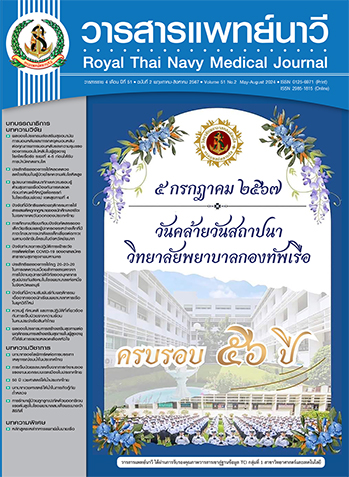Effectiveness of the 20-20-20 Rule in Reducing Digital Eye Strain among Staff at a Social Security Center in a Hospital, Chonburi Province
Main Article Content
Abstract
This quasi-experimental study was conducted to investigate the effectiveness of the 20-20-20 rule in reducing digital eye strain caused by digital device usage among personnel at a social security center in a hospital in Chonburi Province. Simple random sampling method was employed, targeting personnel who spent a minimum of 4 hours per day working with computers, totaling 27 individuals. Data were collected in January 2024 using questionnaires including personal information and the Digital Eye Strain and Risk Level (DESRIL-27) -Thai version. Statistical analysis was performed using Wilcoxon signed rank test to compare the mean ranks of DESRIL-27 scores before and after participating in the program during each week. Additionally, the correlation between the frequency of training sessions and DESRIL-27 scores were analyzed using Spearman's correlation coefficient, with a statistical significance level set at .05.
The majority of the sample group were females (96.3%) with a mean age of 36.22 years. All participants spent at least 4 hours per day working with computers. Analysis revealed a noteworthy decrease in digital eye strain among participants after training sessions in weeks 1, 2, and 3, reaching statistical significance at the 0.05 level. Additionally, a significant correlation emerged between the frequency of training sessions and DESRIL-27 scores during the 2nd and 3rd weeks, also at the 0.05 level. This study demonstrates the effectiveness of the 20-20-20 rule in reducing digital eye strain and highlights the importance of increased training frequency in mitigating digital eye strain.
Article Details

This work is licensed under a Creative Commons Attribution-NonCommercial-NoDerivatives 4.0 International License.
References
Blehm C, Vishnu S, Khattak A, Mitra S, Yee RW. Computer vision syndrome: a review. Surv Ophthalmol. 2005;50(3):253-62.
Sheppard AL, Wolffsohn JS. Digital eye strain: prevalence, measurement and amelioration. BMJ Open Ophthalmol. 2018;3(1):e000146.
Das A, Shah S, Adhikari TB, Paudel BS, Sah SK, Das RK, et al. Computer vision syndrome, musculoskeletal, and stress-related problems among visual display terminal users in Nepal. PLoS One. 2022;17(7):e0268356.
Chamari S, Parkthongsuk P, Tengtraisorn S. Prevalence and factors affecting eye fatigue in computer users at the Faculty of Medicine, Prince of Songkla University. Songklanakarin J Sci Technol 2009;31(2):91-104. (in Thai).
Fagsaad T, Supapong S. Prevalence and associated factors of computer vision syndrome among radiologists, Thailand. RTN Med J 2024;51(1):83-93. (in Thai).
Anshel JR. Visual ergonomics in the workplace. AAOHN J 2007;55(10):414-22.
Anshel JR. Visual ergonomics handbook. New York: CRC Press; 2005. p. 5-75.
Hamid Z, sharbini s, Rahman HA, Idris FI, naing l. The development and validation of a questionnaire measuring Digital Eye Strain and Risk Level (DESRIL-27). Research Square 2023;3(1):1342108.
Chakrabarty S, Sarkar K, Dev S, Das T, Mitra K, Sahu S, et al. Impact of rest breaks on musculoskeletal discomfort of Chikan embroiderers of West Bengal, India: a follow up field study. J Occup Health 2016;58(4):365-72.
Henning RA, Jacques P, Kissel GV, Sullivan AB, Alteras-Webb SM. Frequent short rest breaks from computer work: effects on productivity and well-being at two field sites. Ergonomics 1997;40(1):78-91.
Talens-Estarelles C, Cerviño A, García-Lázaro S, Fogelton A, Sheppard A, Wolffsohn JS. The effects of breaks on digital eye strain, dry eye and binocular vision: testing the 20-20-20 rule. Cont Lens Anterior Eye 2023;46(2):101744.
Nurhikma G, Setyowati D, Ramdan I. Effects of giving 20-20-20 method on reducing computer vision syndrome (CVS) symptoms. Faletehan Health J 2022;9(3):298-307.
Alghamdi WM, Alrasheed SH. Impact of an educational intervention using the 20/20/20 rule on computer vision syndrome. Afr Vision Eye Health 2020;79(1):1-6.
Zulkarnain BS, Loebis R, Aryani T. Sodium hyaluronate eye drops for college students with computer vision syndrome in Indonesia. Folia Med Indones 2022;58(4):293-7.
Anggrainy P, Lubis RR, Ashar T. The effect of trick intervention 20-20-20 on computer vision syndrome incidence in computer workers. J Ophthalmol Ukraine 2020;1(1):22-7.
Schwane JA, Watrous BG, Johnson SR, Armstrong RB. Is lactic acid related to delayed-onset muscle soreness? Phys Sports Med 1983;11(3):124-31.
Cazorla G, Petibois C, Bosquet L, Lége L. Lactate and exercise: myths and realities. Staps 2001;54(1):63-76.

